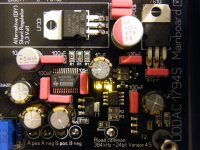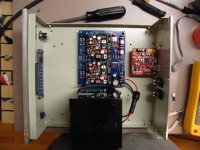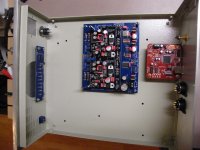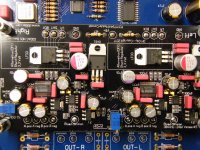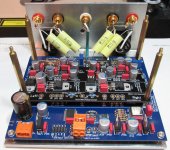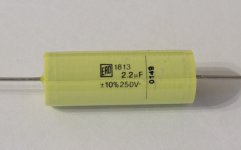Hi there, I have a DDDAC kit on order which will use 3 x DAC's.
Wondering about the load resistors using capacitor coupling.
So RL=134/3=44.66 ohm
So using E24 range 47//920=44.69 ohm a +0.2% variation
Does this look correct, cheers Johno
Or just use 43 ohms. It's very close to what you are aiming for without being more than the recommended resistance.
Is it so that in using the Cinemags 15/15B one can couple them in a balanced mode, and thus double the dac use (like adding decks) but still use the RCA outputs? Does this require a minimum number of dac decks?
Is it so that in using the Cinemags 15/15B one can couple them in a balanced mode, and thus double the dac use (like adding decks) but still use the RCA outputs? Does this require a minimum number of dac decks?
Correct, this is the case with all signal transformers!
Advantages:
- Double Output
- Significant reduction of d2 distortion
- low output impedance over the whole audioband (compared to capacitor output)
With the Cinemags you do not require a minimum nr of Decks, That is only with the Sowters who (thanks to the minimalistic design for optimum transfer and headroom and low distortrion, has lower inductance and hence need a certain low impedance driving them. i.e. 4 decks)
What is the difference between 15/15B and the 600/600C transformer? Would there for example be a preference for one of them in terms of how many decks one have to start with?
Almeg69 said:There is no reason for the safety earth to be connected to any part other than the case.
Be careful! ALL CONDUCTIVE PARTS that can be touched by the user muss be connected to Safety Earth for safety reasons. This includes switches and connectors, etc. Protecting peoples lives goes first! A ground loop breaker may help to avoid audio ground loops in a safe manner (see Rod Elliot website).
I'm still trying to find out if most people connect the -Ve of the Mainboard to the Chassis? It is clearly shown in the Creative Shop built DAC's but perhaps Doede can confirm this is the recommended way to do it?
I'm at the stage where the DAC is working but I am afraid to ground any boards without double checking it's OK to do so.
I hate the magic smoke 😉
I guess they connect the audio-GND to Safety Earth for safety reasons, because the audio-GND is exposed at the outside of the enclosure. This connection may cause ground loops if the DDDAC is hooked up to other devices (amp, pre-amp) that also have a direct connection between audio-GND and Safety Earth. A ground loop breaker will fix this without missing out on safety (as mentioned in my previous post).
I got my 1 board DDDac soldered up and the basic testing indicates everything is normal. All regulators are working properly although I did not try to measure the +8 from the Tent shunts. The current sources easily adjusted to 40mv and the DC output across the load resistors is 2.65 volts. I am powering it from a 12v 12ah battery for this initial test. I'm currently leaning towards a separate power supply box docked to the main chassis. Next up will be to power up the waveI/O, connect it to the main board and wire up the XLR output jacks.
Attachments
Last edited:
Got music from my DDDac. I'm powering the WaveI/o board from an external supply and the DAC with a 12v 12ah battery. I had some trouble getting the USB working but after adjusting some settings in the mac preferences and in pure music I got it working. One odd thing is that the LEDs don't seem to be working quite right. The host active and music streaming leds stay on all the time. The sample rate leds don't seem to agree with what is labelled on the led board but I am getting unique leds lighting for different rates. It may sort itself out after another power cycle.
The sound is certainly good at this point. Too early to draw conclusions, but so far dynamica are excellent and vocals are very natural. The background is dead quiet from the listening chair, no hiss or hum audible and my listening room is very quiet. Just listening to Blue Rodeo- 5 Days in May and the drums sound very real and fast. The guitar solo is just starting and I've got to stop typing to listen!
The sound is certainly good at this point. Too early to draw conclusions, but so far dynamica are excellent and vocals are very natural. The background is dead quiet from the listening chair, no hiss or hum audible and my listening room is very quiet. Just listening to Blue Rodeo- 5 Days in May and the drums sound very real and fast. The guitar solo is just starting and I've got to stop typing to listen!
Last edited:
Be careful! ALL CONDUCTIVE PARTS that can be touched by the user muss be connected to Safety Earth for safety reasons. This includes switches and connectors, etc. Protecting peoples lives goes first! A ground loop breaker may help to avoid audio ground loops in a safe manner (see Rod Elliot website).
I guess I should have been more specific. When the safety earth is connected to the case, it also connects everything that is attached to the case i.e. Switches , external heat sinks, Pin 1 on XLR outlets etc and power inlet connector if using an external power supply.
Which means the safety earth wire connected to the chassis may have to withstand the worst case scenario of 16 A.
Although if you have an RCCB the most it would carry would be 30 m/a.
Hello,
I intend to use Raspberry + kali reclocker (Volumio) + DDDAC.
So I will lose the front panel LED display since I plug directly into I2S of the motherboard?
Is there another possibility to keep the LEDs display ?
I intend to use Raspberry + kali reclocker (Volumio) + DDDAC.
So I will lose the front panel LED display since I plug directly into I2S of the motherboard?
Is there another possibility to keep the LEDs display ?
I am addressing those who have intercalated the Kali reclocker between WaveIO and the DDDAC.
Have you noticed a clear difference in sound reproduction with and without the kali reclocker
Thanks for the answer
Pierre
Have you noticed a clear difference in sound reproduction with and without the kali reclocker
Thanks for the answer
Pierre
I am addressing those who have intercalated the Kali reclocker between WaveIO and the DDDAC.
Have you noticed a clear difference in sound reproduction with and without the kali reclocker
Thanks for the answer
Pierre
I've done that (see post 6119 and some of the stuff before this post). Adding the Kali resulted in a substantial improvement of the audio quality (more than fiddling with PSU tweaks). Once I get around to build my second DDDAC, I will include the Kali right from the beginning.
Have you used the Doede 5V PSU to power the kali or have you added a dedicated PSU.Originally Posted by mbrennwa
I've done that (see post 6119 and some of the stuff before this post). Adding the Kali resulted in a substantial improvement of the audio quality (more than fiddling with PSU tweaks). Once I get around to build my second DDDAC, I will include the Kali right from the beginning.
Have you used the Doede 5V PSU to power the kali or have you added a dedicated PSU.
I started with the DDDAC Vdd 5V supply, then tried a dedicated supply for the Kali (xformer -> rectifier -> first filter cap -> 7805 -> second filter cap). I couldn't tell a difference between the two. I believe the Kali has it's own regulators on board.
Don't use the WaveIO USB 5V supply to keep the noise of the USB GND away from Kali.
Just give the Kali a go and see if you like it.
Some hints (see my earlier posts about how I learned these the hard way):
(i) use short wires between WaveIO <-> Kali and between Kali <-> DDDAC
(ii) use separate GND wires for each I2S data wire
(iii) maybe use terminating resistors on the I2S lines. I am not convinced they are necessary, but I put them in to see if they help while I was fighting with the I2S connections, and I just left the resistors in once I fixed the I2S by following points (i) and (ii).
Last edited:
I have some output capacitor recommendations.
I have just built another DAC Board tester that has RCA and XLR outputs.
I was trying various capacitors that I had to hand, but I made an Ebay search for 2.2uf 250v
poly capacitors as I wanted the best quality without going to Mundorf or even Audionote ...
When they arrived, I was able to complete my tester and bought a Tent board as a benchmark reference.
I had it powered by my Farnell Dual 30v 2a power supply and sat back to listen.
The sound was stunningly good with the one Tent board and going through the poly capacitors in balanced mode. I was shocked and pleased at the same time, it was that good even comparing it with my fully tricked out 16 stacker with Sowter transformers.
So if you want stunning sound for a small outlay, here is the link to the capacitor vendor.
10x MKT-Capacitor ax. 2,2mF 250V DC ; 13x31,5mm ; MKT18135222551Q ; 2,2uF | eBay
I also used Aluminium Polymer Capacitors in place of the supplied electrolytic ones which also helped.
They are not silly money either but will give a lift to the already reference quality sound.
Here are the pictures below 🙂
I have just built another DAC Board tester that has RCA and XLR outputs.
I was trying various capacitors that I had to hand, but I made an Ebay search for 2.2uf 250v
poly capacitors as I wanted the best quality without going to Mundorf or even Audionote ...
When they arrived, I was able to complete my tester and bought a Tent board as a benchmark reference.
I had it powered by my Farnell Dual 30v 2a power supply and sat back to listen.
The sound was stunningly good with the one Tent board and going through the poly capacitors in balanced mode. I was shocked and pleased at the same time, it was that good even comparing it with my fully tricked out 16 stacker with Sowter transformers.
So if you want stunning sound for a small outlay, here is the link to the capacitor vendor.
10x MKT-Capacitor ax. 2,2mF 250V DC ; 13x31,5mm ; MKT18135222551Q ; 2,2uF | eBay
I also used Aluminium Polymer Capacitors in place of the supplied electrolytic ones which also helped.
They are not silly money either but will give a lift to the already reference quality sound.
Here are the pictures below 🙂
Attachments
I bulid it ,its okyou need to put resistors here to make it work properly. With the transformer output you use both dacs (pos and neg) and one is not biased as you see.
with capacitor (SE) you have no problem as you only use one dac
also, volume pot should always be at the receiving side of things. the low output impedance (good for driving the interlink) is now thrown away.
the last point is audio tip, has nothing to with the noise. that is just adding the two Rload resistors
good luck !
doede
It have small nosic .
When I bulid it ,it have nosic ,why?
Is the value of load resistor critical ?
Just fired up a 3 tier DDDAC 1794
Distorted sound from both channels
I used load resistors supplied with kit 4 x 34 ohm.
They should be 44 ohm, could this be the cause of distorted sound ?
DDDAC - 12V looks ok clamp meter indicates around 550ma for above configuration.
Tried unit on SFDIF only.
No smoke leds on DAC boards light up
Found it difficult to adjust 2 of the pots for 40mv they were on different boards
Thanks in advance for advice
Johno
Just fired up a 3 tier DDDAC 1794
Distorted sound from both channels
I used load resistors supplied with kit 4 x 34 ohm.
They should be 44 ohm, could this be the cause of distorted sound ?
DDDAC - 12V looks ok clamp meter indicates around 550ma for above configuration.
Tried unit on SFDIF only.
No smoke leds on DAC boards light up
Found it difficult to adjust 2 of the pots for 40mv they were on different boards
Thanks in advance for advice
Johno
I bulid it ,its ok
It have small nosic .
When I bulid it ,it have nosic ,why?
I think it is better to help you off line, that is easier. pls send an email to my mail at dddac -dot- com account with good pictures what you have done, plus measurement values of the 40mV and DC values of the POS and NEG terminals versus "Common" also let me know how it is all connected to the rest of your chain. from there we will take it, ok?
- Home
- Source & Line
- Digital Line Level
- A NOS 192/24 DAC with the PCM1794 (and WaveIO USB input)
